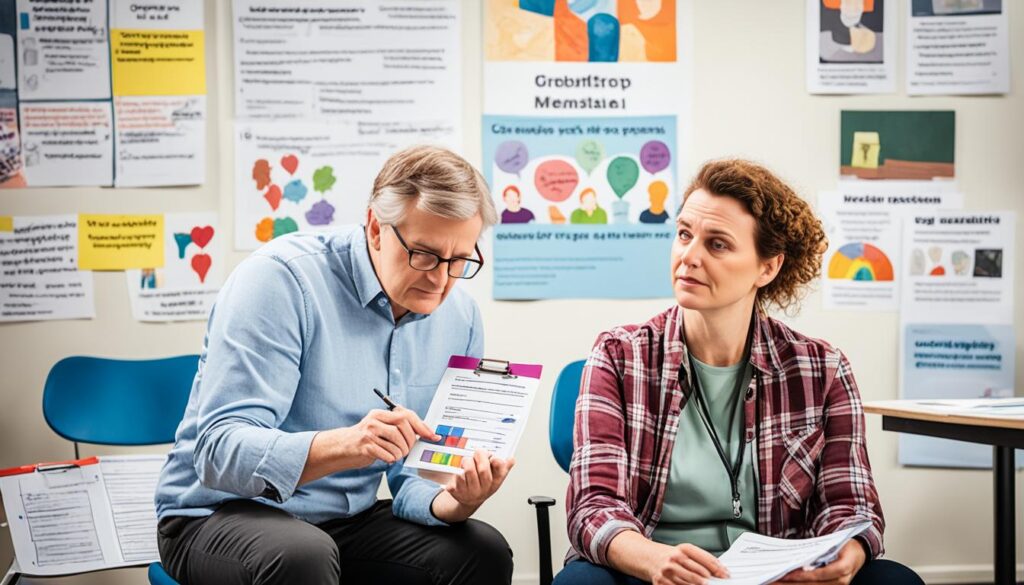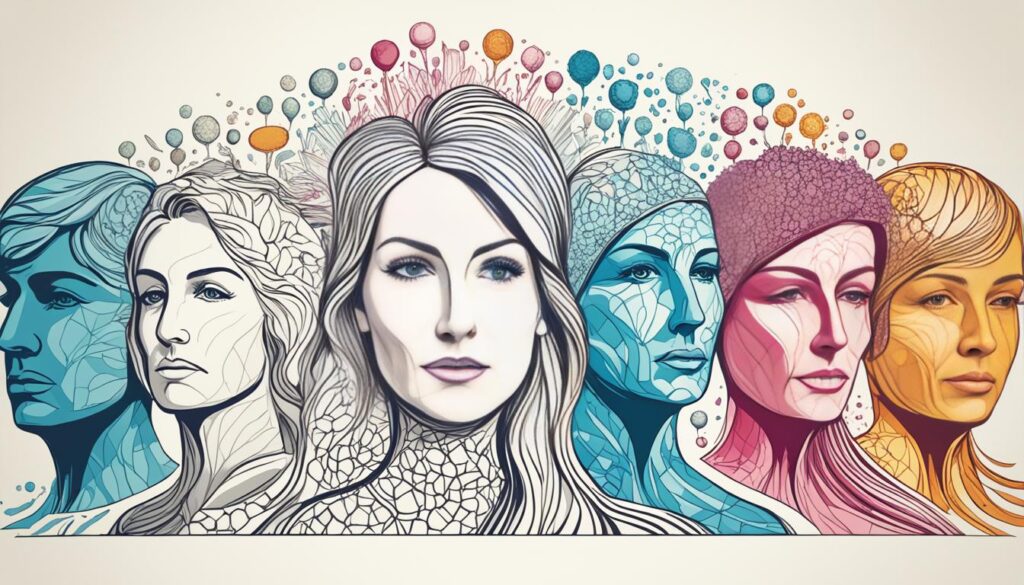Anhedonia is a condition where people feel no joy in activities they once loved. It’s a key sign of depression and can really affect someone’s drive, relationships, and life quality. It can come from mental health issues like depression, bipolar disorder, and schizophrenia.
This makes it important to understand and recognize. People with anhedonia often feel numb and find it hard to look forward to fun events or do things they used to enjoy. Knowing about anhedonia is crucial because it deeply affects how people feel.
Key Takeaways
- Anhedonia is a core feature of various mental disorders, primarily depression.
- It manifests as emotional numbness and a lack of motivation for previously enjoyable activities.
- Individuals with anhedonia are often at a greater risk of using substances recreationally.
- The condition can lead to heightened risks of suicidal thoughts, especially among those with PTSD.
- Research indicates older adults with anhedonia have an increased risk of developing dementia.
Understanding Anhedonia
Anhedonia is a serious mental health issue. It makes it hard to feel joy or pleasure. People with anhedonia often feel numb and lack motivation. This makes even simple tasks feel like a huge effort.
Anhedonia isn’t just tied to depression. It can also be seen in conditions like schizophrenia, bipolar disorder, Parkinson’s disease, and diabetes. This shows how widespread it can be.
The anhedonia definition is about losing interest in activities that once made you happy. This can make it tough to connect with others. It can lead to feeling very alone and increase depression and anxiety.
Studies suggest anhedonia might be linked to brain chemistry issues, especially with dopamine. Dopamine is key for feeling pleasure and reward. Those with anhedonia might not have enough dopamine, making them feel more numb and unmotivated.
New treatments like ketamine might help with anhedonia. As research goes on, we might find more ways to help people with this condition.
What is Anhedonia?
Anhedonia is a big challenge for those who face it. It makes it hard to enjoy things that used to bring happiness. People with this condition often feel a deep lack of pleasure in their daily lives. This can make them feel very alone and upset.
It’s important to understand anhedonia well for treating mood disorders like depression.
Definition of Anhedonia
The anhedonia definition says it’s a key symptom of not being able to feel pleasure. This lack of joy touches many parts of life, from hobbies to relationships. Studies show that anhedonia often goes hand in hand with depression symptoms. About 70% of people with major depression also have anhedonia, showing how closely these two are linked.
Distinction from Depression
Anhedonia vs. depression is an important topic in mental health. Anhedonia is about not being able to enjoy things, while depression has more symptoms like sadness, tiredness, and feeling hopeless. You can have anhedonia without being officially depressed, but the two often go together.
The lack of pleasure can make people pull away from others and feel numb inside. This makes the situation even harder to deal with.
Types of Anhedonia
Anhedonia comes in different forms, mainly social and physical anhedonia. These types show how it affects people on emotional and sensory levels.
Social Anhedonia
Social anhedonia means feeling a big withdrawal from social interactions and a deep lack of social pleasure. People with this type find it hard to enjoy being around others. They might end up isolating themselves from others and avoiding group activities.
This condition is often mixed up with social anxiety disorder. Social anxiety is more about feeling anxious in social situations. It’s not the same as not enjoying social settings.
Physical Anhedonia
Physical anhedonia is about feeling less pleasure from physical sensations. Those with this type might feel numb to touch, including affection, favorite foods, or even sex. This lack of enjoyment can make them feel frustrated and hurt their relationships and life quality.
Symptoms of Anhedonia
Anhedonia shows up in many ways, affecting how we feel and connect with others. It’s important to know these signs to see anhedonia as a real mental health issue. The main signs are losing interest in things we used to enjoy, feeling numb, and pulling away from others.
Loss of Interest in Activities
One big sign of anhedonia is losing interest in activities that used to make us happy. People might stop doing hobbies they loved, making life feel less fulfilling. This can lead to feeling alone, hurting relationships, and lowering our overall happiness.
Emotional Numbness
Feeling numb is a key part of anhedonia. Those with it often can’t feel joy or pleasure, even in good or bad situations. This makes it hard to have real feelings, leaving them feeling empty or just not caring.
Withdrawal from Social Interactions
People with anhedonia often pull away from others. Avoiding social events can make relationships worse and make them feel more alone. This makes the problem worse, making it harder to get support from friends and family.

| Symptom | Description |
|---|---|
| Loss of Interest | Decreased participation in activities once enjoyable, such as hobbies and social events |
| Emotional Numbness | Inability to feel happiness, leading to a flat emotional state across experiences |
| Social Withdrawal | Avoidance of social interactions contributing to strained relationships and isolation |
Spotting these signs early can help get the right help. This can make life and emotional health better.
Causes of Anhedonia
Anhedonia is a complex condition caused by mental, physical, and trauma factors. It often results from mental health issues, physical conditions, and past traumas. These factors lead to a psychological impact and make it hard to feel pleasure.
Link to Mental Health Disorders
Anhedonia is linked to mental health issues like depression, bipolar disorder, and schizophrenia. Diseases linked to anhedonia greatly affect how people feel. Those with schizophrenia or substance use disorders may feel less pleasure, while depression can make it worse.
The severity of anhedonia is tied to these health conditions. A lack of dopamine makes emotional challenges harder to handle.
Physical Health Conditions
Some medical conditions can cause anhedonia. For example, Parkinson’s disease lowers dopamine levels, leading to motor and non-motor symptoms, including anhedonia. Chronic stress also affects dopamine and can disrupt the brain’s reward pathways.
Poor nutrition and diet can reduce dopamine production, making mood worse. This shows how physical health impact affects mental well-being.
Impact of Trauma and PTSD
Trauma has a big effect on mental health. PTSD can lead to long-term changes in how emotions are managed. Trauma can change how people feel pleasure, causing symptoms like anhedonia.
As emotional responses to stress and trauma change, the risk of anhedonia grows. This makes mental health recovery harder.
How Anhedonia Affects Daily Life
Anhedonia deeply changes daily routines and life quality. People with this condition face big challenges. These challenges lead to less engagement in activities and strained relationships. Knowing these effects helps us see the need for support and possible help.
Loss of Motivation
Feeling unmotivated is a key symptom of anhedonia. It makes everyday tasks hard. Even simple things can feel too much.
This barrier makes people put things off, leading to more frustration. As tasks grow, so does the feeling of not being good enough. This makes it harder to get motivated again.
Diminished Interest in Hobbies
Many people with anhedonia lose interest in hobbies they loved. Activities that once brought joy now feel like work. This leads to feeling disconnected and unhappy, making mental health worse.
Apathy in Relationships
Anhedonia also hurts personal relationships. It causes emotional distance, making others feel ignored or not understood. Feeling disconnected from social life adds stress to relationships.
Communication problems can make people feel isolated. This makes dealing with anhedonia even harder.
Anhedonia Explained
Anhedonia is a condition where people feel no joy in activities they once loved. It’s a big part of feeling down, making it hard for those affected to understand why they feel numb. This can affect many parts of life, like work and personal relationships.
There are two main types of anhedonia: social and physical. Social anhedonia makes it hard to connect with others, leading to weaker relationships. People with this type find it hard to share feelings or enjoy time with others.
Physical anhedonia means feeling no pleasure in things like exercise or being close with someone. It can make you lose interest in hobbies and even sex. This shows how anhedonia is linked to other mental health issues like depression and bipolar disorder.
Studies show that anhedonia changes how the brain works, especially with dopamine. This affects how we feel pleasure in daily life. To deal with anhedonia, we need to fix the psychological and physical issues that cause it.
For more on how anxiety affects the body, check out physical symptoms of anxiety.
Diagnosis of Anhedonia
Diagnosing anhedonia requires a detailed mental health check-up by experts. They look at symptoms, personal stories, medical background, and overall health. Anhedonia often shows up with depression and other mental health issues like schizophrenia and bipolar disorder.
There are two kinds of anhedonia: social and physical. Social anhedonia makes it hard to connect with others and enjoy social events. Physical anhedonia stops people from feeling pleasure from touch, which can really lower their life quality.
It’s key to know what’s causing anhedonia to diagnose it right. This could be due to chronic illnesses, PTSD, or substance abuse. Getting help from a doctor can lead to treatments that fix the root mental health problems.

Studies show that changes in brain activity, especially with dopamine, are linked to anhedonia. A correct diagnosis helps manage anhedonia better, leading to better health outcomes as treatment goes on.
For more on handling anxiety and panic attacks, check out how to manage anxiety symptoms.
Importance of Seeking Help
Getting help for anhedonia is key. People with this condition do well with professional advice. It’s important to know when you need support to manage symptoms and feel better. Starting early can make a big difference and help you find better ways to cope.
Consulting Mental Health Professionals
Looking for help can lead to many therapy options. Experts in mental health offer plans made just for you. Working with therapists helps you understand your feelings and find ways to deal with them. They can also help fix the mental health problems linked to anhedonia.
Therapy can make everyday life and your feelings better. It helps you not just face your problems but also improve your life. Getting help from experts is crucial for a better life and keeping away from serious thoughts of suicide.
Treatment Options for Anhedonia
Treating anhedonia means using both medicines and therapy. It’s important because up to 75% of adults and young people with depression also have anhedonia. Knowing about treatment options can help people feel more interested in life again.
Medications: SSRIs and Beyond
SSRIs are common medicines for mental health. They help with depression and anhedonia by affecting serotonin, a key mood regulator. But, over half of people with depression don’t get better with SSRIs right away. Other options include:
- Venlafaxine: Good for major depressive disorder, especially with anxiety.
- Augmented depression therapy: This method targets anhedonia well, better than CBT alone.
- Ketamine: Studies show it can improve dopamine, offering new hope for treatment.
Therapy Approaches: CBT and Other Methods
Cognitive behavioral therapy (CBT) is a key therapy for anhedonia. It helps change negative thoughts and behaviors. Other therapies that might help include:
- Behavioral activation: It focuses on doing more enjoyable activities, even if it’s not always the best option.
- Reward processing therapies: These aim to make activities that were once fun more appealing again.
- Support groups: Sharing stories and tips with others can offer extra support.
| Treatment Type | Description | Effectiveness |
|---|---|---|
| SSRIs | Common antidepressants that regulate serotonin levels | Varied; high initial response with follow-up options |
| Venlafaxine | Antidepressant effective for comorbid anxiety and depression | High; specific to individual symptoms |
| Cognitive Behavioral Therapy | Therapy aimed at modifying negative thought patterns | Effective; works well for many individuals |
| Ketamine | Experimental treatment enhancing dopamine activity | Promising; still under research |
Combining effective medicines and specific therapies can greatly improve anhedonia. People with symptoms should talk to healthcare experts to find the right treatment plan for them.
Brain Chemistry and Anhedonia
Exploring the link between brain chemistry and anhedonia shows us how complex this emotional state is. Psychological, neurobiological, and neurological factors all play a big part in how we feel pleasure. At the heart of this is the neurotransmitter dopamine.
The Role of Dopamine
Dopamine is key in the brain’s reward system, affecting how we see pleasure. If dopamine production or response goes wrong, it can lead to anhedonia. This shows a strong link between dopamine and anhedonia.
Studies reveal that those with major depressive disorder have less activity in the brain’s reward areas. These include the nucleus accumbens and anterior cingulate cortex. This highlights the importance of fixing dopamine issues to help with depression.
Brain Regions Involved
Some brain areas are crucial for feeling anhedonia. The ventral striatum and prefrontal cortex are key in reward processing and managing emotions. If these areas are not working right, it can make it hard to enjoy daily activities.
Knowing which brain areas are involved helps us find better treatments. This includes focusing on fixing dopamine issues.
Anhedonia in Different Populations
Anhedonia is a big challenge for many people, affecting their mental health. It’s especially tough for those dealing with depression and other health issues. Knowing how it affects different groups helps us find better ways to help.
Impact on Those with Depression
People with depression often feel anhedonia, making their emotional struggles worse. About 37% of those with depression say they feel anhedonia a lot. This can make them lose motivation and feel hopeless.
Anhedonia makes treating depression harder, affecting mental health and recovery. The link between anhedonia and depression shows we need special treatments for both at the same time.
Effects on Individuals with Other Illnesses
Anhedonia also affects people with other health issues, not just depression. Studies show that those with schizophrenia and bipolar disorder often feel anhedonia too. About 45% of people with schizophrenia experience it, making their lives and treatment harder.
The psychological impact of anhedonia in these cases highlights the need for more research. We need to find better ways to help people with both anhedonia and other illnesses. This can help doctors create better treatment plans for these patients.

Alternative Therapies for Anhedonia
Anhedonia makes it hard to feel pleasure. New treatments are needed that go beyond what we’ve tried before. Ketamine therapy is one new option that could help people feel better fast.
Innovative Treatments like Ketamine
Ketamine therapy is a big step forward for treating anhedonia. It helps people who haven’t gotten better with other treatments. This therapy can make people feel better quickly, which is important for their mental health.
Exploring Lifestyle Changes
Changing your lifestyle can also help with anhedonia. Doing regular exercise, eating well, and having a daily routine can make you feel stronger emotionally. Taking care of yourself and focusing on your mental health is key to getting better.
| Therapy Type | Description | Potential Benefits |
|---|---|---|
| Ketamine Therapy | Rapid-acting treatment targeting mood symptoms | Quick alleviation of anhedonia symptoms |
| Physical Activity | Regular exercise to boost endorphins and mood | Increases motivation and overall well-being |
| Balanced Diet | Nutrition-focused approach to enhance mental health | Supports brain function and emotional stability |
| Structured Routines | Establishing predictability in daily activities | Reduces anxiety and engenders a sense of control |
| Self-Care | Personal practices to improve well-being | Promotes positive emotional states and resilience |
Preventing Anhedonia
Making smart lifestyle choices can help prevent anhedonia. These choices boost emotional health and may lower the risk of anhedonia, especially for those with depression symptoms.
Healthy Lifestyle Choices
Healthy habits make mental resilience and emotional health better. Here are key lifestyle changes to consider:
- Maintain Social Connections: Being with friends and family is key for feeling good emotionally.
- Regular Physical Activity: Working out boosts mood and motivation, helping to fight anhedonia.
- Practice Mindfulness: Meditation and yoga help with stress and feeling numb.
- Healthy Nutrition: Eating well supports brain health, which affects mood and feelings of stability.
- Set Realistic Goals: Reaching small goals can make you feel accomplished and interested in life again.
By adopting these healthy habits, people can fight anhedonia and improve their emotional health.
Current Research on Anhedonia
Research on anhedonia is always changing, focusing on its roots in the brain and its link to mental health issues. Studies are looking closely at depression, showing a strong connection between anhedonia and conditions like schizophrenia. Anhedonia affects about 80% of people with major depression, making it very important in treating mental health.
Scientists are finding biomarkers that could predict if antidepressants will work for some people, with up to 55.3% showing promise. They’re also looking into genes to understand depression better, finding a strong link between certain genes and anhedonia.
New treatments like ketamine are being closely watched. Research shows it can help 83% of people feel better quickly, which could help with anhedonia too. Inflammation is also being studied, with findings linking it to anhedonia in people with depression.
Scientists are working hard to understand anhedonia and its effects on health. Early studies suggest it can lower quality of life, increase anxiety, and make daily tasks harder. These findings could lead to better treatments for those struggling with anhedonia.
Conclusion
Anhedonia is a complex issue that greatly impacts the lives of many. Studies show that up to 20% of young people have had a depressive episode by the time they turn 18. About 50% to 78% of those with Major Depressive Disorder also experience anhedonia. This shows we need more research and effective treatments.
Adolescents are especially at risk, making up 73% of those studied on anhedonia. There are also differences between physical and social anhedonia. This means we might need different treatments for different people. The research suggests we could see new treatments soon, helping people find joy and motivation again.
Researchers are looking into the brain’s patterns in anhedonia. They’re focusing on how it affects attention and finding new things. This could lead to more tailored treatments. As we learn more, there’s hope for better mental health for those with anhedonia. They won’t be left out by their feelings anymore.


